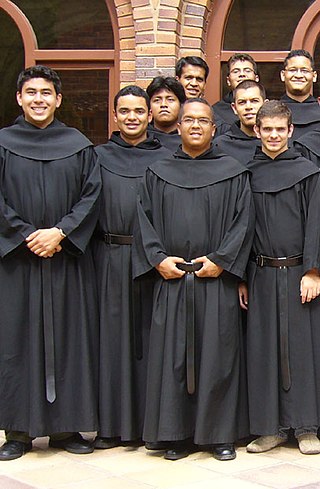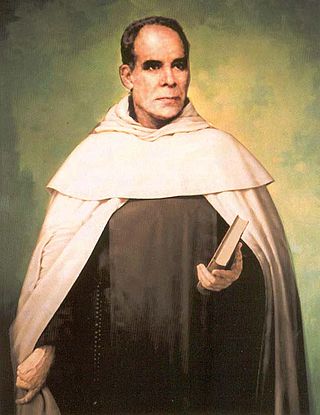
The Order of the Brothers of the Blessed Virgin Mary of Mount Carmel, known as the Carmelites or sometimes by synecdoche known simply as Carmel, is a Roman Catholic mendicant religious order for men and women. Historical records about its origin remain uncertain, but it was probably founded in the 12th century on Mount Carmel in the Crusader States. Berthold of Calabria, as well as Albert of Vercelli, have traditionally been associated with the founding of the order, but few clear records of early Carmelite history have survived. The order of Carmelite nuns was formalised in 1452.

John of the Cross, OCD was a Spanish Catholic priest, mystic, and Carmelite friar of converso origin. He is a major figure of the Counter-Reformation in Spain, and he is one of the thirty-seven Doctors of the Church.

Augustinians are members of several religious orders that follow the Rule of Saint Augustine, written in about 400 AD by Augustine of Hippo. There are two distinct types of Augustinians in Catholic religious orders dating back to the 12th–13th centuries:

A friar is a member of one of the mendicant orders of the Roman Catholic church. The term, first used in the 12th or 13th century, distinguishes the mendicants' itinerant apostolic character, exercised broadly under the jurisdiction of a superior general, from the older monastic orders' allegiance to a single monastery formalized by their vow of stability. A friar may be in holy orders or be a brother. The most significant orders of friars are the Dominicans, Franciscans, Augustinians, and Carmelites.

A scapular is a Western Christian garment suspended from the shoulders. There are two types of scapulars, the monastic and devotional scapular; both forms may simply be referred to as "scapular". As an object of popular piety, a scapular serves to remind wearers of their commitment to live a Christian life.

The Scapular of Our Lady of Mount Carmel belongs to the habit of both the Carmelite Order and the Discalced Carmelite Order, both of which have Our Lady of Mount Carmel as their patroness. In its small form, it is widely popular within the Latin Church of the Catholic Church as a religious article and has probably served as the prototype of all the other devotional scapulars. The liturgical feast day of Our Lady of Mount Carmel, July 16, is popularly associated with the devotion of the Scapular.

The term third order signifies, in general, lay members of Christian religious orders, who do not necessarily live in a religious community such as a monastery or a nunnery, and yet can claim to wear the religious habit and participate in the good works of a great order. Roman Catholicism, Lutheranism and Anglicanism all recognize third orders.

The Third Order of Our Lady of Mount Carmel, also known as the Lay Carmelites, is a third order of the Carmelite Order of the Ancient Observance, established in 1476 by a bull of Pope Sixtus IV. It is an association of people who choose to live the Gospel in the spirit of the Carmelite Order and under its guidance. Its members are mainly lay people.

Our Lady of Mount Carmel, or Virgin of Carmel, is the title given to the Blessed Virgin Mary in her role as patroness of the Carmelite Order, particularly within the Catholic Church. The first Carmelites were Christian hermits living on Mount Carmel in the Holy Land during the late 12th and early to mid-13th century. They built in the midst of their hermitages a chapel which they dedicated to the Blessed Virgin, whom they conceived of in chivalric terms as the "Lady of the place." Our Lady of Mount Carmel was adopted in the 19th century as the patron saint of Chile.

Simon Stock, OCarm was an English Catholic priest and saint who lived in the 13th century and was an early prior of the Carmelite order. The Blessed Virgin Mary is traditionally said to have appeared to him and given him the Carmelite habit, the Brown Scapular. Thus, popular devotion to Stock is usually associated with devotion to Our Lady of Mount Carmel.

The Sisters of the Apostolic Carmel are members of a Carmelite religious institute dedicated to female education. It was founded in the latter part of the 19th century by Mother Veronica of the Passion, OCD, under the guidance of her mentor, Bishop Marie Ephrem of the Sacred Heart, OCD, who had envisioned the birth of "a Carmel for the missions" in India, devoted to teaching and education.

The Discalced Carmelites, known officially as the Order of the Discalced Brothers of the Blessed Virgin Mary of Mount Carmel or the Order of Discalced Carmelites, is a Catholic mendicant order with roots in the eremitic tradition of the Desert Fathers. The order was established in the 16th century, pursuant to the reform of the Carmelite Order by two Spanish saints, Teresa of Ávila (foundress) and John of the Cross (co-founder). Discalced is derived from Latin, meaning "without shoes".

In Roman Catholicism, the Sabbatine Privilege refers to a belief in the early liberation of souls from Purgatory, on the first Saturday after death, through the special intercession and petition of the Virgin Mary. The Privilege is based on an apocryphal Papal Bull Sacratissimo uti culmine, dated 3 March 1322 and attributed to Pope John XXII. The Bull is universally regarded by scholars as inauthentic.

The Fivefold Scapular, also known as Redemptorist Scapular, is a sacramental made up of five best-known of the early scapulars in the Catholic Church: the Brown Scapular of the Carmelites, the Blue Scapular of the Immaculate Conception, the Black Scapular of the Servites, the Red Scapular of the Passion, and the White Scapular of the Most Holy Trinity. There are 17 total officially approved scapulars of the Catholic Church.

The Third Order of Saint Dominic, also referred to as the Lay Fraternities of Saint Dominic or Lay Dominicans since 1972, is a Catholic third order which is part of the Dominican Order.

The Carmelite Monks or Monks of the Most Blessed Virgin Mary of Mount Carmel are a public association within the Diocese of Cheyenne, dedicated to a humble life of prayer. The Wyoming Carmelites claim loyalty to the Magisterium of the Catholic Church and to the Carmelite charism. Their life includes strict separation from the world and the living of the cloistered Carmelite spirituality and way of life established by John of the Cross and Teresa of Jesus. In accord with the Carmelite Rule, they engage in manual labor and the study of Carmelite spirituality in the solitude of the mountains, with the firm hope of attaining to Union with God.
The Book of the First Monks is a medieval Catholic book in the contemplative and eremitic tradition of the Carmelite Order, thought to reflect the spirituality of the Prophet Elijah, honored as the Father of the Order.

The Constitutions of the Carmelite Order stand as an expression of the ideals and spirit of the Order of Our Lady of Mount Carmel. Foundational sources for the Constitutions include the desert hermit vocation as exemplified in the life of the Prophet Elijah. For the Carmelite the contemplative vocation is exemplified par excellence in the life of the Virgin Mary, beloved to the Order under the title of Our Lady of Mount Carmel. Additionally, the Carmelite Rule of St. Albert and the Book of the First Monks comprise fundamental points of reference in the life and spirituality of the Order.

The Stella Maris Monastery is a Catholic Christian monastery for Discalced Carmelite monks, located on the slopes of Mount Carmel in Haifa, Israel.

Francisco Palau y Quer, was a Catalan Discalced Carmelite priest. Growing up in the chaos of the Peninsular War in Spain, he followed both the life of a hermit and of a missionary preacher in the rural regions of Catalonia. He founded the School of Virtue, which was a model of catechetical teaching for adults, in Barcelona. In 1860 he founded a Carmelite Third Order congregation for both men and women, in the Balearic Islands. The legacy of this foundation is carried on by two religious congregations for women who serve throughout the world.



















